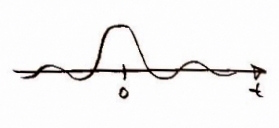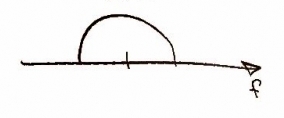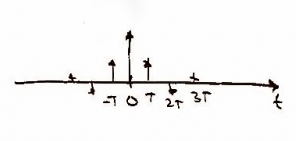Homework Eight
How does a CD player work with no oversampling, but digital filtering (1x oversampling)?
Recall that when the audio for a music CD is produced it has an infinite amount of data points which can be expressed as in the time domain (Figure 1) and in the frequency domain (Figure 2).


When one wants to store the data of (i.e. reading the data onto a CD in this case) an infinite number of data points is not ideal -- in fact, it is impossible. Therefore, we must sample the data at the (typical) rate of . This will give us a periodic function which we will call is the sampling period. It is common to allow a sampling rate of twice the frequency at which a human can hear (i.e. 2 x 22 kHz) -- that means, kHz.
Recall from class that in order to sample the original function, , we need to use a delta function. In other words, the continuous function of can be written as (Figure 3)
